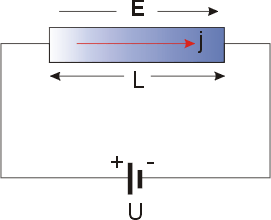משתמש:בנצי/ארגז חול 24: חוק וידמן-פרנץ
חוק ויידמן-פרנץ קובע שהיחס בין התרומה האלקטרונית למוליכותה התרמית של מתכת לבין התרומה שלה למוליכותה החשמלית של המתכת נמצא ביחס ישר לטמפרטורה.
תיאורטית, קבוע הפרופורציה L, הידוע כמספר לורנץ, שווה ל- .
חוק אמפירי זה, קרוי על-שמם של גוסטב היינריך ויידמן ורודולף פרנץ אשר דווחו ב-1853 שליחס יש בקירוב אותו ערך למתכות שונות באותה טמפרטורה.
In physics, the Wiedemann–Franz law states that the ratio of the electronic contribution to the thermal conductivity (κ) and the electrical conductivity (σ) of a metal is proportional to the temperature (T).[1]
Theoretically, the proportionality constant L, known as the Lorenz number, is equal to
This empirical law is named after Gustav Wiedemann and Rudolph Franz, who in 1853 reported that κ/σ has approximately the same value for different metals at the same temperature.[2] The proportionality of κ/σ with temperature was discovered by Ludvig Lorenz in 1872.
Qualitatively, this relationship is based upon the fact that the heat and electrical transport both involve the free electrons in the metal.
The mathematical expression of the law can be derived as following. Electrical conduction of metals is a well known phenomenon and is attributed to the rather free conduction electrons. It is measured as sketched in the figure. The current density j is observed to be proportional to the applied electric field and follows Ohm's law where the prefactor is the specific electrical conductivity. Since the electric field and the current density are vectors we have expressed Ohm's law here in bold face. The conductivity can in general be expressed as a tensor of the second rank (3×3 matrix). Here we restrict the discussion to isotropic, i.e. scalar conductivity. The specific resistivity is the inverse of the conductivity. Both parameters will be used in the following.
Drude (c. 1900) realized that the phenomenological description of conductivity can be formulated quite generally (electron-, ion-, heat- etc. conductivity). Although the phenomenological description is incorrect for conduction electrons, it can serve as a preliminary treatment.
The assumption is that the electrons move freely in the solid like in an ideal gas. The force applied to the electron by the electric field leads to an acceleration according to
This would lead, however, to an infinite velocity. The further assumption therefore is that the electrons bump into obstacles (like defects or phonons) once in a while which limits their free flight. This establishes an average or drift velocity Vd. The drift velocity is related to the average scattering time as becomes evident from the following relations.
Limitations of the theory[עריכת קוד מקור | עריכה]
Experiments have shown that the value of L, while roughly constant, is not exactly the same for all materials. Kittel[3] gives some values of L ranging from L = 2.23×10−8 W Ω K−2 for copper at 0 °C to L = 3.2×10−8 W Ω K−2 for tungsten at 100 °C. Rosenberg[4] notes that the Wiedemann–Franz law is generally valid for high temperatures and for low (i.e., a few Kelvins) temperatures, but may not hold at intermediate temperatures.
In many high purity metals both the electrical and thermal conductivities rise as temperature is decreased. In certain materials (such as silver or aluminum) however, the value of L also may decrease with temperature. In the purest samples of silver and at very low temperatures, L can drop by as much as a factor of 10.[5]
In degenerate semiconductors, the Lorenz number L has a strong dependency on certain system parameters: dimensionality, strength of interatomic interactions and Fermi-level. This law is not valid or the value of the Lorentz number can be reduced at least in following cases: manipulating electronic density of states, varying doping density and layer thickness in superlattices and materials with correlated carriers. [6] [7]
See also[עריכת קוד מקור | עריכה]
External links[עריכת קוד מקור | עריכה]
References[עריכת קוד מקור | עריכה]
- ^ Jones, William; March, Norman H. (1985). Theoretical Solid State Physics. Courier Dover Publications. ISBN 0486650162.
- ^ Franz, R.; Wiedemann, G. (1853). "Ueber die Wärme-Leitungsfähigkeit der Metalle". Annalen der Physik (בגרמנית). 165 (8): 497–531. Bibcode:1853AnP...165..497F. doi:10.1002/andp.18531650802.
- ^ Kittel, C., 2005. Introduction to Solid State Physics. John Wiley and Sons
- ^ Rosenberg, H. 2004. The Solid State. Oxford University Press
- ^ K. Gloos, C. Mitschka, F. Pobell and P. Smeibidl. Cryogenics, 30 (1990), p. 14, DOI: 10.1016/0011-2275(90)90107-N
- ^ A. J. Minnich, M. S. Dresselhaus, Z. F. Ren and G. Chen. Bulk nanostructured thermoelectric materials: current research and future prospects, Energy & Environmental Science, 2009, 2, 466-479, DOI: 10.1039/b822664b
- ^ Paothep Pichanusakorn, Prabhakar Bandaru. Nanostructured thermoelectrics, Materials Science and Engineering: R: Reports, Volume 67, Issues 2-4, 29 January 2010, Pages 19-63, ISSN 0927-796X, DOI: 10.1016/j.mser.2009.10.001.






